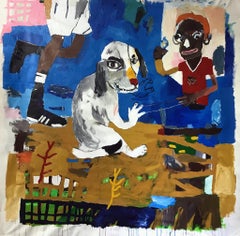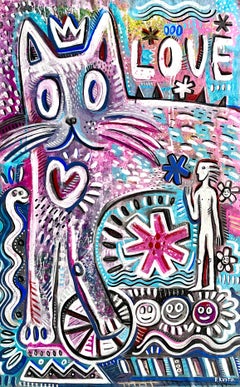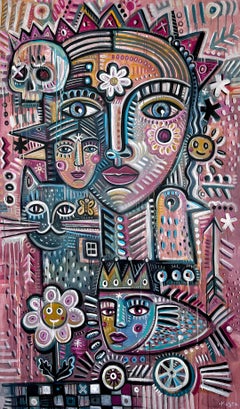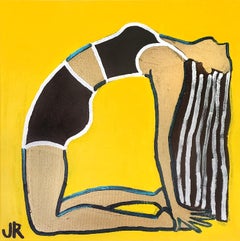Folk Art Figurative Paintings
21st Century and Contemporary Folk Art Figurative Paintings
Canvas, Crayon, Acrylic
2010s Folk Art Figurative Paintings
Acrylic
2010s Folk Art Figurative Paintings
Acrylic
Artist Comments
A young woman stands on the beach, a red flower adding a touch of whimsy to her pink bikini. Bold lines outline her figure as stylized waves crash behind her....
21st Century and Contemporary Folk Art Figurative Paintings
Acrylic
2010s Folk Art Figurative Paintings
Acrylic
Artist Comments
Jessica JH Roller paints a self-portrait of a mastered yoga pose. It captures the geometric beauty of the posture called Ustrasana, or Camel. The subtle curve...
21st Century and Contemporary Folk Art Figurative Paintings
Acrylic
20th Century Folk Art Figurative Paintings
Canvas, Oil
2010s Folk Art Figurative Paintings
Acrylic
1980s Folk Art Figurative Paintings
Paper, Gouache
2010s Folk Art Figurative Paintings
Oil, Board
Early 2000s Folk Art Figurative Paintings
Oil, Wood Panel
1980s Folk Art Figurative Paintings
Plaster, Casein, Wood Panel
1990s Folk Art Figurative Paintings
Mirror, Plaster, Wood, Acrylic
1970s Folk Art Figurative Paintings
Tempera, Postcard
20th Century Folk Art Figurative Paintings
Masonite, Oil
2010s Folk Art Figurative Paintings
Acrylic, Mixed Media, Wood Panel
21st Century and Contemporary Folk Art Figurative Paintings
Paper, Acrylic
1960s Folk Art Figurative Paintings
Acrylic
20th Century Folk Art Figurative Paintings
Canvas, Oil
1970s Folk Art Figurative Paintings
Oil, Board
1870s Folk Art Figurative Paintings
Oil
20th Century Folk Art Figurative Paintings
Canvas, Oil
1960s Folk Art Figurative Paintings
Canvas, Oil
20th Century Folk Art Figurative Paintings
Canvas, Oil
2010s Folk Art Figurative Paintings
Acrylic
1970s Folk Art Figurative Paintings
Canvas, Oil
2010s Folk Art Figurative Paintings
Acrylic, Canvas
20th Century Folk Art Figurative Paintings
Fabric, Paint
Early 20th Century Folk Art Figurative Paintings
Canvas, Oil
Mid-20th Century Folk Art Figurative Paintings
Burlap, Oil
1920s Folk Art Figurative Paintings
Metal
Mid-20th Century Folk Art Figurative Paintings
Burlap, Oil
Late 20th Century Folk Art Figurative Paintings
Oil
1990s Folk Art Figurative Paintings
Enamel
21st Century and Contemporary Folk Art Figurative Paintings
Mixed Media
Mid-20th Century Folk Art Figurative Paintings
Burlap, Oil
20th Century Folk Art Figurative Paintings
Mirror, Plaster, Wood, Acrylic, Pencil
2010s Folk Art Figurative Paintings
Cotton Canvas, Mixed Media, Acrylic, Stretcher Bars
2010s Folk Art Figurative Paintings
Wood Panel, Acrylic
20th Century Folk Art Figurative Paintings
Gouache
1960s Folk Art Figurative Paintings
Oil
21st Century and Contemporary Folk Art Figurative Paintings
Paper, Mixed Media, Acrylic
20th Century Folk Art Figurative Paintings
Paper, Oil, Alkyd
20th Century Folk Art Figurative Paintings
Wood, Paint
21st Century and Contemporary Folk Art Figurative Paintings
Wood, Acrylic, Board
Mid-20th Century Folk Art Figurative Paintings
Oil
2010s Folk Art Figurative Paintings
Acrylic, Canvas
Mid-20th Century Folk Art Figurative Paintings
Oil
Mid-20th Century Folk Art Figurative Paintings
Burlap, Oil
Mid-20th Century Folk Art Figurative Paintings
Oil, Board
2010s Folk Art Figurative Paintings
Canvas, Acrylic
Late 20th Century Folk Art Figurative Paintings
Mixed Media
20th Century Folk Art Figurative Paintings
Canvas, Oil
20th Century Folk Art Figurative Paintings
Canvas, Oil
1950s Folk Art Figurative Paintings
Canvas, Oil
2010s Folk Art Figurative Paintings
Canvas, Oil
1980s Folk Art Figurative Paintings
Canvas, Acrylic
21st Century and Contemporary Folk Art Figurative Paintings
Canvas, Oil Crayon, Acrylic
2010s Folk Art Figurative Paintings
Linen, Oil
20th Century Folk Art Figurative Paintings
Canvas, Oil




